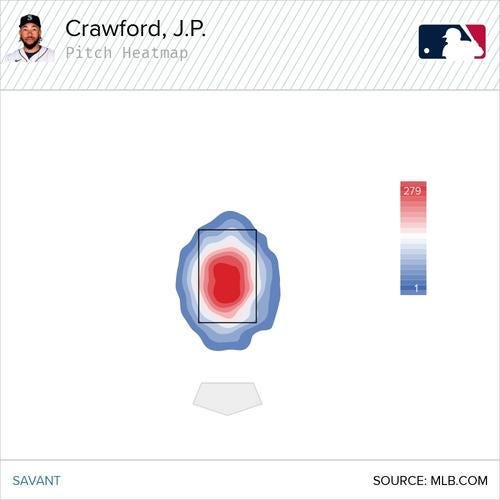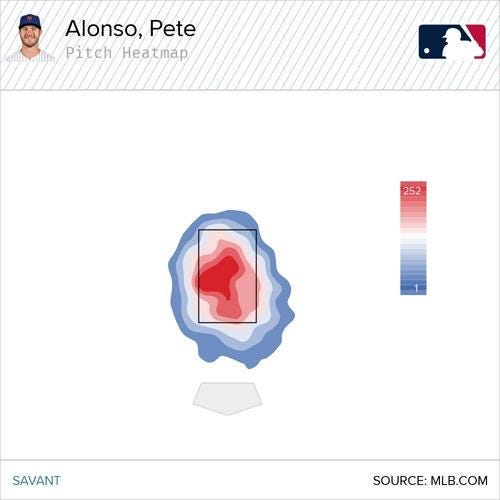J.P. Crawford is historically selective
It’s fair to say J.P. Crawford is by far the most selective hitter the Mariners have had in more than a decade. A few slight improvements to quality of contact could make him a top shortstop in MLB.
Last year, 47.8% of Crawford’s swings were at pitches in the heart region of the strike zone-–10th most in MLB.
It was technically his worst performance in the metric yet. He dedicated 49.4% of his swings to heart pitches in 2018, and 48.5% in both 2017 and 2019. Each would rank in the 99th percentile on the all-time leaderboard given a full season.
Since his debut, 48.5% of Crawford’s swings have come on pitches over the heart of the plate. That ranks fifth among all 737 players with at least 1,500 swings in the pitch tracking era.
Here’s what that looks like:
For context, here’s the free swinging Pete Alonso:
Basically, Crawford has dedicated a greater portion of his swings to pitches down the middle than just about any other player since we‘ve been able to measure. Obviously comparing 800 plate appearances to decades long careers is a bit of a favorable query, but the point is Crawford has shown signs of elite plate discipline with year-to-year consistency.
The pitches Crawford takes are also interesting. His swing rate in 2020 was just 41% (20th percentile):
Even as he committed a large portion of swings to pitches in the heart region, he didn’t actually swing at many of them — a calling card of many any of the best and most selective hitters in MLB like Trout, Betts and Yelich.
His swing decisions in two strike counts were also excellent, swinging at just about everything right down the middle but remaining relatively picky overall:
And he doesn’t just have a great eye. He was one of the best at turning swings into balls in play and he rarely whiffed. He also reached the launch angle sweet spot near league average.
Crawford is effectively the Jerry Dipoto “Control the Zone” prototype: swing at the most hittable pitches and don’t swing otherwise.
But the list of best swing-take guys includes Garrett Hampson and Yoshi Tsutsugo, and the list of worst includes Tim Anderson and Bryce Harper — pitch selection is not the only thing that matters.
Crawford posted a whelming 2020 line of .255/.336/.338 with a 94 wRC+. That’s passable for a shortstop but a bit of a wasted opportunity considering the plate discipline.
The lack of production was largely due to poor quality of contact. He qualified 1.8% batted balls as barrels (5th percentile), and only 31.1% were hit harder than 95 mph (15th percentile). His .329 xwOBACON finished among the league’s worst (10th percentile).
And despite his affinity for heart region pitches, he didn’t really fare much better on those swings. His .355 wOBA and .369 xwOBA on heart pitches ranked near the 20th percentile. Only 37.8% were hard hit (15th percentile).
Of course, Crawford still benefited from an outsized portion of his swings going to those pitches — his quality of contact in other regions was significantly worse — but he didn’t create enough relative value to offset the rest of his contact profile.
Scott Servais told Ryan Divish of The Seattle Times in November that Crawford had a tendency to roll over on weakly hit ground balls to the pull side, and suggested he would benefit from using the whole field.
“…it’s not the prettiest all the time, but he makes really good swing decisions. And when he stays committed to using the whole field and not trying to pull the ball through the shift — good things happen.”
Here’s how Crawford fared to each field 2020:
Crawford went the other way as much as anyone in MLB and was OK doing so in a relative sense. And he actually had fine success going up the middle. But he dug himself a deep hole by getting almost no production on the pull side.
Even keeping the oppo-heavy splits, Crawford could bolster his production by improving his quality of contact on pulled balls. Nearly 60% of his batted balls to the pull side were on the ground, and his xwOBA on pulled groundballs was more than .300 points lower than in the air.
And really that’s kind of it. There’s a lot of places in Crawford’s profile where a few tweaks could make a huge difference in overall production. I could get more granular and talk about pitch types and pitcher handedness and counts and situations. But it all leads back to the same place: Crawford picks really good pitches to swing at and doesn’t really do a lot with them.
The next step forward is pretty obvious and it’s kind of up to him at this point. I like how Matthew Roberson at Lookout Landing put it in his 2021 preview of Crawford.
“The problem is, how do you just start hitting the ball harder? Squaring up MLB pitching is already impossible, and I certainly don’t know how to do it. You gotta hope the Mariners are aware of these troubling batted ball trends as well and are cooking something up.
Will we see a swing transformation? A significantly altered approach at the plate? Regardless of what does or doesn’t happen in the lab, when the 2021 season begins, J.P. Crawford’s habits and results in the batter’s box will be something to keep both eyes on.”
To his credit, Crawford seems to feel as if he’s going to improve. He told Lauren Smith of The News Tribune in January that he’s added weight and feels more explosive.
“I’m feeling good about my offense this year,” he said. “I’ve been working every day this offseason with Evan and (Sam) Haggerty down here in the complex, and the swing feels good.
“It’s shorter and quicker and the ball is jumping off better than it ever has before, so I’m really excited to get this year going.”
To be clear, Crawford doesn’t really need to improve. He’s already a slightly below average hitter with Gold Glove defense at a premium position. The Mariners would surely love the stability of a a 2.5 fWAR player for the next four seasons.
But there’s such an obvious path for Crawford to be one of the top hitting shortstops — and players — in MLB. Dan Szymborski made Crawford one of his 2021 breakout candidates and shared some insight on his ZiPS projections:

Crawford does so many things well already that even a modest quality of contact improvements turns him into an above average hitter and top shortstop in baseball.
Many players have built off excellent plate discipline to improve their quality of contact (Marcus Semien and Max Muncy are great templates). Maybe Crawford can be next. The first month of this season should say a lot about his role with the team heading into the future. I guess we’ll see.
J.P. Crawford is historically selective was originally published in Swings and Takes on Medium, where people are continuing the conversation by highlighting and responding to this story.









